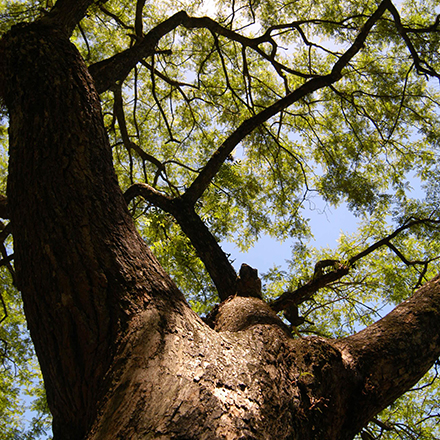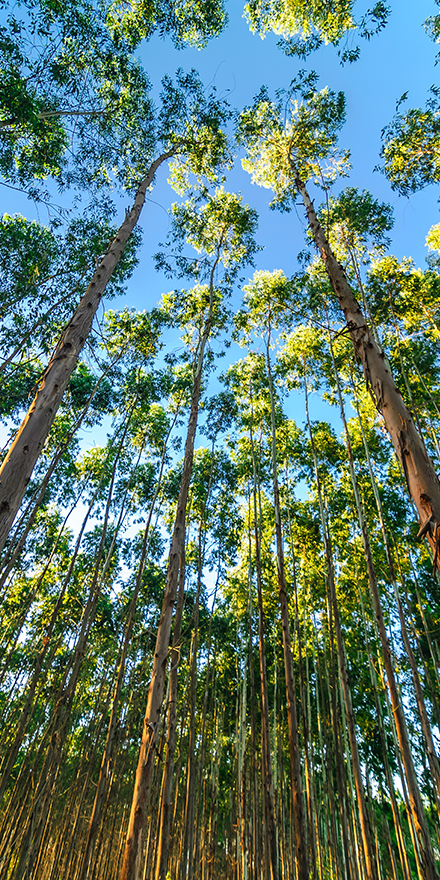In Brazil tobacco is cultivated mainly in the states of Rio Grande do Sul, Santa Catarina and Parana, which represent about 98% of the domestic production of this crop. From 2000 to 2015 the total production of all types of leaf tobacco increased from approximately 578,000 MT (approximately 310,000 ha) to approximately 692,000 MT (approximately 315,000 ha). In terms of volume it does not list among the 20 most important agricultural production of the country and represents only around 0.13% of Brazil’s 227 million hectares of agricultural land.
Over 154,000 families currently grow tobacco in the South of Brazil. About 71% own their farms, while the rest work on rented land. The average tobacco farm covers about 15.3 ha, but only 17.6% of the farm is cultivated with tobacco: 26.9% of the farm land is covered with trees: one part (15.7%) is native forest and is not available as source of wood due the Brazil legislation, while the other part (11.2%) is reforested area, to provide fuel for the FCV barns and poles for the air-cured tobacco barns, and the rest is cultivated with the other crops which are part of the normal rotation program of the farm (maize, black beans, rice, potatoes, vegetables) or left for pasture or fallow.
Of the total production of Brazilian tobacco, Flue-Cured Virginia (FCV) represents about 85% of the total tobacco production of Brazil. FCV is a type of tobacco that is dried in barns supplied with flues which run from externally fed fire boxes, heat-curing the tobacco without exposing it to smoke and slowly raising the temperature over the course of the curing (one week). All other types of tobacco are cured by air, which means that the leaves are hung in naturally ventilated barns and allowed to dry over a period of four to eight weeks.
In terms of curing barn for FCV tobacco, normally one barn can cover the production of 2 hectares of tobacco. The normal ratio on FCV tobacco farms is to have 1 ha of woodlot per every curing barn, which allows a sustainability of 110%. Burley tobacco is cured in barns which are made with wooden poles, mainly from Eucalyptus trees, with a ceramic tile roof and sides closed by manageable plastic curtains. 1 ha of woodlot can produce sufficient poles to build 14 barns, which need rebuilding after 15 years.
The Atlantic Forest (Mata Atlântica) is considered to be one of the most important biomes in the Country, comprising 17 Brazilian States and parts of Argentina and Paraguay. With a biodiversity very similar to the Amazon jungle, the Atlantic Forest was expressively destroyed, starting in the 16th century, by different types of Brazilian settlers who were responsible for reducing its size to 10% of the initial cover. In Rio Grande do Sul, however, this scenario tends to change. In 1992 UNESCO established the Mata Atlântica Biosphere Reserve. In order to respond to the special need for large-scale ecosystem conservation and management, a wide range of management, scientific and community organizations joined together in setting up the Mata Atlântica Biosphere Reserve system. Almost all States participating already have state-level committees.
Due to the importance in protect the remaining Mata Atlântica forest, the Brazilian legislation forbids the deforestation of this region. Only for special purposes and under State Environmental Protection Agency license trees may be cut down, but in this case tree planting is mandatory on the same river basin on the ratio of 15 trees x 1 tree cut down.
In 2000 many meetings took place between the Environment Public Attorney of Santa Catarina State, Santa Catarina Environmental Protection Agency (FATMA), the Tobacco Companies Trade Association (SindiTabaco), the Tobacco Farmers Association (Afubra) and others farmers’ representatives. The objective was to identify and implement actions to avoid the use of wood from native trees on the tobacco production, mainly as firewood. In November of 2000 a term of agreement of compliant behavior was signed by the parties.
The most important points of this document are:
- The tobacco companies should provide finance to farmers that are not self-sufficient in firewood to by wood from reforestation with exotic species (from Eucalyptus species).
- The tobacco companies and Afubra should launch campaigns to promote reforestation, native forest preservation and to inform the farmers about the risks of not complying with the environmental legislation. Since 2000 every year meetings and seminars have been organized and printed materials have been regularly distributed to the farmers.
- The tobacco companies should give incentives for and promote reforestation with exotic species to achieve self-sufficiency in firewood the flue-cured tobacco farmers. Eucalyptus seedling have been supplied and financed by the tobacco companies to farmers that have land available for reforestation. Also the tobacco companies should provide technical assistance to farmers in terms of reforestation.
- The tobacco companies should provide transport of firewood from Eucalyptus to farmers that are not self-sufficient in firewood (farmers without land and with limited land available).
- The tobacco companies should add a clause to the annual contract with farmers that they will not buy tobacco cured with firewood from irregular origin (from native species and/or without license).
- The tobacco companies should not have contracts with farmers who were sued by the Environmental Protection Agency.
- The tobacco companies should provide annually an agreement signed by the farmers identifying the origin of the wood that will be used to cure the flue-cured tobacco.
Annually copies of the all signed agreements are sent to the Santa Catarina Environmental Protection Agency.
The tobacco companies signed a similar agreement with the Parana State Environmental Protection Agency, IAP, in 2004. The State of Rio Grande do Sul did not laid down specific conditions, mainly because deforestation in this state is virtually non-existent due to the active control by the environment agency and very high penalties for contravening the law. Also there is good supply of wood (Eucalyptus sp. and Acacia Negra) from independent afforestation schemes.
SindiTabaco, Afubra, Ibama (Brazilian Institute of the Environment and Renewable Natural Resources) and the Ministry of the Environment signed unprecedented agreements in 2011 for the preservation of the Atlantic Forest. The commitments undertaken are as follows:
- Contractual requirement ensuring that the production and commercialization of tobacco comply with the environmental standards in force, under penalty of terminating existing contracts;
- Company rural extension agents are responsible for keeping the farmers aware of the importance of protecting the native vegetation of the Atlantic Forest Biome;
- Monitoring by satellite an area of 6,899.47 km², with the aim to keep a close watch on the evolution of the production systems and the conservation of the remaining forest lots in three areas of great importance for tobacco farming in Rio Grande do Sul;
- Elaboration and distribution of 200 thousand primers addressing the subject of sustainable rural holding management and respect for the environment;
- Support to the recovery of degraded areas in the municipality of Segredo (RS) and to the conservation of the Atlantic Forest biome through a partnership with the Federal University of Santa Maria (UFSM).
At the beginning of the 1980’s, SindiTabaco had already initiated a campaign to make the tobacco farmers self-sufficient in terms of fire-wood. The target was to transplant 1.0 ha of Eucalyptus per barn in 5 years, transplanting 500 seedlings per year. After 5 years the entire area should be transplanted and, depending on the soil fertility and woodlot management, the first 500 trees could be ready to be cut down. Eucalyptus trees re-grow very well after being cut and will be ready to cut again after 5/6 year. This cycle can be repeated 2-3 times. So with one hectare of Eucalyptus per barn the farmer can be self-sufficient per 15-20 years without replacing the woodlot.
The campaign is still in place and most of the farmers are self-sufficient in wood; only farmers without land or with limited land available are not self-sufficient.
In parallel, also Afubra established a tree nursery close to its experimental centre of Santa Cruz do Sul and provides seedlings raised with the best seeds provided by the Institute of Forest Research (IPEF), by the College of Agriculture Luiz de Quiroz, by the Ministry of Agriculture and well-known nursery companies such as Aracruz, Klabin and Rigesa.
ULT, as a tobacco merchant with direct contracts with farmers, also finances the production of Eucalyptus seedlings by commercial tree nurseries, and their distribution to farmers, based on precise annual contracts with a number of nurseries. Farmers sign an agreement binding them to prove the origin of wood used for tobacco curing. For farmers who do not own land or have too small a farm to set aside an area for woodlots, ULT supplies wood from Eucalyptus forests or providing financing so that the farmers can go and buy the wood from other farmers or from reforestation companies. Both the ULT FCV and Burley contracted farmers are self-sufficient in wood and have in average over 10% of wood in excess that they can sell.
ULT continues to provide and finance Eucalyptus seedlings to farmers. Between 2001 and 2016 ULT financed the raising and supplied over 80 million seedlings of different trees between to ensure that the tobacco farmers under contract would be totally self-sufficient in their needs of wood.







